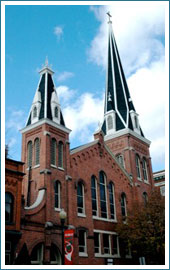
Established along tuscarora creek by general adam Stephen, a longtime associate and sometime rival of George Washington, Martinsburg was incorporated as the county seat in 1778. Stephen named the town for his friend, Lord Fairfax’s nephew Thomas Bryan Martin. George Washington visited Martinsburg on occasion and attended a wedding at historic Aspen Hall.
In 1842, the B&O Railroad arrived bringing new growth and prosperity. Large warehouses and hotels were erected as well as a major railroad complex including a roundhouse and engine repair shops.
As a strategic railroad hub and gateway to the Shenandoah Valley, Martinsburg was hotly contested in the early years of the Civil War, changing hands more than 30 times. It served as both a staging area and a rehabilitation center for retreating troops. In spite of being a reluctant part of the new state of West Virginia, by 1877 Martinsburg was one of three candidates for location of the state capital. Social history was also made in 1877 when agrarian Martinsburg found itself the site of America’s first national labor strike which involved railroad workers.
By the turn of the 20th-century, Martinsburg was an important textile center. The last mill closed in 1970 and many mill buildings have been transformed into commercial, government and education centers. The flourishing 21st century downtown also includes art and cultural activities.
Martinsburg’s several phases of development can be best explored by walking tours of its nine historic districts filled with architecturally significant buildings.
West Virginia’s fastest-growing city, Martinsburg remains the only urban center along the Trail.
For More Information: 1-800-498-2386